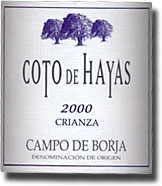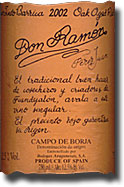|


ver the last few weeks, Kim and I have
had the opportunity to taste through ten wines from the large Spanish
producer,
Bodegas Aragonesas. These included seven bottlings from the
Coto de Hayas line, along with Don Ramon Oak - aged Red, a
Castillo de Fuendejalon Crianza and a Crucillon Tinto. All
but three of the Coto de Hayas fall well under the parameters of
Wine Probation
®,
and most showed quite good quality. The wines were tasted over several
nights, giving us the opportunity to get to know them a little, rather
than rushing through them in one sitting and taking "snapshots."
 Bodegas
Aragonesas is located in the Campo de Borja Denomination of Origin,
with vineyards in the foothills of the Cordillero Iberico, south
of Rioja. These occupy an area of 10,000 acres, with a height of
between 1,300 and 1,475 feet on a formation of small hills facing
southeast. (Another 10,000 acres is planted to olive and almond trees,
with 10,000 remaining open land or forest.) Garnacha (grenache) is the
predominant varietal grown (some vineyards being 100 years old), with
20% Tempranillo and lesser amounts of Syrah, Cabernet Sauvignon, Merlot
and Chardonnay, in a region that produces more than 13,000 tons of
grapes annually. Fermentation is carried out in steel tanks, and the
ageing mainly in American oak casks (some French oak is used as well),
with a capacity for producing nearly 400,000 gallons, or 7 to 8 million
bottles a year, 60% of the production of the entire Denomination of
Origin. Bodegas
Aragonesas is located in the Campo de Borja Denomination of Origin,
with vineyards in the foothills of the Cordillero Iberico, south
of Rioja. These occupy an area of 10,000 acres, with a height of
between 1,300 and 1,475 feet on a formation of small hills facing
southeast. (Another 10,000 acres is planted to olive and almond trees,
with 10,000 remaining open land or forest.) Garnacha (grenache) is the
predominant varietal grown (some vineyards being 100 years old), with
20% Tempranillo and lesser amounts of Syrah, Cabernet Sauvignon, Merlot
and Chardonnay, in a region that produces more than 13,000 tons of
grapes annually. Fermentation is carried out in steel tanks, and the
ageing mainly in American oak casks (some French oak is used as well),
with a capacity for producing nearly 400,000 gallons, or 7 to 8 million
bottles a year, 60% of the production of the entire Denomination of
Origin.
All prices listed are suggested retail; the wines are imported by
Vintage Wine Distributor, Inc., Solon, OH & Columbus, OH.
2003 Coto de Hayas Campo de Borja
Chardonnay, $5.99, 13% alc.: Kim described the taste of this pale to
medium gold colored chardonnay as "like drinking the juice out of a can
of peaches." And indeed, the aromatics are reminiscent of overripe
peaches, pears and even a little apricot, shaded with subtle floral
overtones, and being not at all characteristic of chardonnay as we know
it. There's more of the same in the mouth, though the flavors are a bit
less ripe, with medium to medium full body and a somewhat thick, not
quite unctuous texture. If this is something of an oddball, I could find
good things to say about it were it not for the very low acidity
present, which does give it a certain "syrup from canned peaches"
quality. A little zip would make this work, but it's just not there; it
was all we could do to finish one glass apiece.
2003 Coto de Hayas Campo de Borja Rosado, 95%
Garnacha (from vineyards over 30 years old), 5% Tempranillo (from
vineyards over 15 years old), $5.99, 13% alc.: An intense strawberry
pink in color, this exudes an assertive bouquet of black cherry,
raspberry and strawberry, along with little hints of something like
smoke and meat. Flavors echo, turning dry and slightly earthy, and yet
there's a very ripe quality here, along with some darker notes to the
fruit than in many ros‚s. Medium bodied, with good acidity, this shows
good QPR (quality - price - ratio). Kim describes it as "very quaffable,
and a good choice for a hot summer afternoon on a beach or deck."
2003 Coto de Hayas Campo de Borja
Tinto, 50% Garnacha (from vineyards over 40 years old), 20% Tempranillo
(from vineyards over 25 years old), 20% Syrah (from vineyards over 10
years old), 10% Cabernet Sauvignon (from vineyards over 10 years old),
$5.99, 13% alc.: Ruby garnet in color, with an effusive nose of
black cherry, red plum, raspberry and strawberry, shaded with hints of
leather and smoke lurking in the background; these follow through on the
palate with plenty of fruit, and more substance and presence than one
might expect these days from a $5.99 red. Medium to medium full bodied,
with moderate tannins, good acidity and a decent finish, this is another
offering that shows good QPR as an every day red.
 2003
Coto de Hayas Campo de Borja Crianza, 60% Garnacha (from vineyards over
30 years old), 40% Tempranillo (from vineyards over 20 years old), nine
months in American oak, $7.99, 13% alc.: Dark garnet in color, with
sweet dark plum, blackberry and black cherry aromas accented with a dash
of pepper and a whiff of smoke; flavors echo with an earthy base
underneath it all, a good dose of tannins, good acidity and just a bit
of a bite at first, but that pretty much smoothes out with 45 minutes in
the glass. Tannins turn a bit burry on the otherwise nice finish, and
this is a wine that should actually improve with a few years in the
bottle. Despite the time it saw in American oak casks, it shows no
distinguishable "oakiness;" another good QPR selection, this. 2003
Coto de Hayas Campo de Borja Crianza, 60% Garnacha (from vineyards over
30 years old), 40% Tempranillo (from vineyards over 20 years old), nine
months in American oak, $7.99, 13% alc.: Dark garnet in color, with
sweet dark plum, blackberry and black cherry aromas accented with a dash
of pepper and a whiff of smoke; flavors echo with an earthy base
underneath it all, a good dose of tannins, good acidity and just a bit
of a bite at first, but that pretty much smoothes out with 45 minutes in
the glass. Tannins turn a bit burry on the otherwise nice finish, and
this is a wine that should actually improve with a few years in the
bottle. Despite the time it saw in American oak casks, it shows no
distinguishable "oakiness;" another good QPR selection, this.
2003 Coto de Hayas Campo de Borja
Tempranillo Cabernet, 85% Tempranillo (from vineyards over 25 years
old), 15% Cabernet Sauvignon (from vineyards over 10 years old), four
months in American oak, $8.99, 13.5% alc.: This ruby dark garnet
colored blend is something of a disappointment after the last two, as it
comes off like nothing so much as red pop with alcohol and some tannic -
acidic bite. It shows moderate spice over black cherry and raspberry
aromas; these turn a little darker on the palate, but seem simple when
compared with the Tinto and Crianza, and those two cost less. Some
tannins and zippy acidity give this a burry quality in the mouth, and
the finish turns earthy and a little twiggy. Decent enough for pizza and
burgers, but a glass and a half was enough for this taster. The American
oak doesn't seem to have done much for this, one way or another. Mayhaps
a year or two in the bottle will smooth out the rough spots some.
2000 Coto de Hayas Campo de Borja Reserva, 100%
Garnacha (from selected vineyards over 40 years old), fourteen months in
American oak, $11.99, 13.5% alc.: Dark garnet color, with black
cherry, red plum and raspberry aromatics that show a certain candied
aspect and a whiff of smoke; these impressions follow through on the
palate with an earthy underbelly and just a bit of a tannic - acidic
bite. There's none of the red pop character like in the previous
selection, but there seems to be a little something missing on the mid -
palate, while a decent finish turns a little more earthy. It seems to
have the fruit to go another year or two, in order to allow for the
tannins to soften a bit, and though I found it fairly pleasant and
enjoyable, Kim found it "boring and mundane."
2003 Coto de Hayas Campo de Borja Garnacha
Centenaria, 100% Garnacha (from three vineyards over 100 years old, with
only 5,500 vines; production limited to 10,000 bottles), four months in
American oak, $13.99, 13.5% alc.: This dark garnet garnacha may not
be all that complex, but it certainly pumps out plenty of pure, rich,
slightly candied black cherry and raspberry flavors and aromas on a
medium full to full bodied frame. Medium tannins, zippy acidity and a
little alcoholic heat give this a somewhat burry mouth feel at first,
but an hour's worth of air smoothes it out nicely. It'll be even better
with a few years to mellow the tannins, and shows reasonably good value
for the price.
 2002
Don Ramon Oak Aged Red Wine, 75% Garnacha, 25% Tempranillo, three months
in American oak, $5.99, 12.5% alc.: Ruby dark garnet in color, with
an effusive creamy cherry cough drop and aquarium nose; flavors turn
more toward deeper, darker black cherry and raspberry on a medium to
medium full bodied frame, with moderate tannins and balanced acidity. A
subtle earthiness underneath the bright fruit adds some depth and
complexity, making for a harmonious glass of red wine, and very good QPR. 2002
Don Ramon Oak Aged Red Wine, 75% Garnacha, 25% Tempranillo, three months
in American oak, $5.99, 12.5% alc.: Ruby dark garnet in color, with
an effusive creamy cherry cough drop and aquarium nose; flavors turn
more toward deeper, darker black cherry and raspberry on a medium to
medium full bodied frame, with moderate tannins and balanced acidity. A
subtle earthiness underneath the bright fruit adds some depth and
complexity, making for a harmonious glass of red wine, and very good QPR.
2000 Castillo de Fuendejalon Crianza,
75% Garnacha, 25% Tempranillo, six months in American oak, $6.99, 12.5%
alc.: With the same varietal percentages as the Don Ramon, this ruby
garnet is like nothing so much as a variation on the same theme (one
which has carried through a number of the garnacha - based wines in this
report), with its rich black cherry character and earthy undertones.
It's less expressive on the nose than the previous selection, with a
touch more toasty oak, and as it opens, it shows hints of underbrush.
Soft tannins and zippy acidity make this food friendly, but there's no
reason not to sip it by itself, and it's yet another solid QPR offering.
2003 Crucillon Campo de Borja Tinto,
100% Garnacha, $4.99: Yet another variation on the Garnacha theme
here, this ruby dark garnet displays a cheery cherry nose that would do
Santa Claus proud, with deeper, darker earthy black cherry and plum
flavors that show a little more earth than the previous two selections.
With moderate tannins and good acidity, this is not a complex wine, but
it is harmonious, easy to drink and food friendly, pairing well with
Kim's delicious pot roast. What more could you ask for from a $5 red?!
Many thanks to Kathleen Flynn of
The Marchetti Co., for sending these wines for us to taste. If
you're looking for good to excellent QPR reds, these are some prime
candidates to investigate.
 Reporting from Day-twah, Reporting from Day-twah,
Bastardo
|